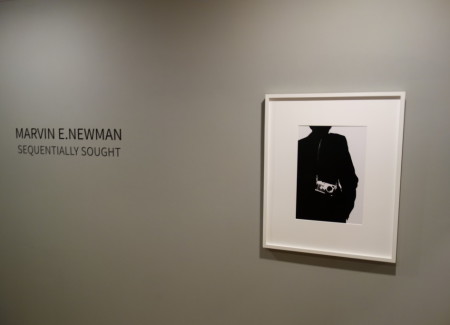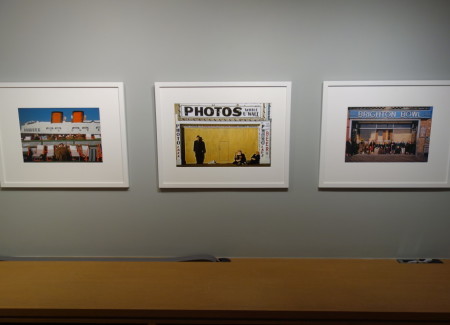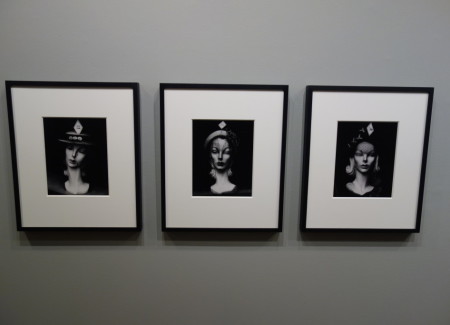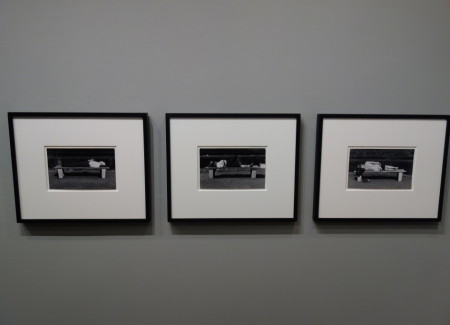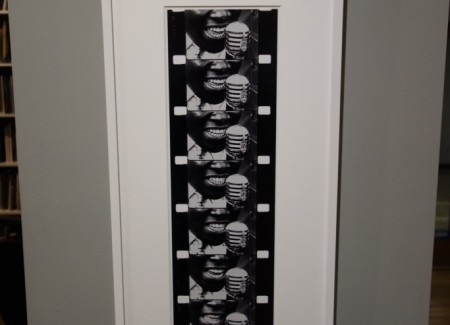JTF (just the facts): A total of 56 black and white and color photographs, variously framed and matted, and hung against light grey walls in the main gallery space and the book alcove. 43 of the black and white works are vintage gelatin silver prints, made between 1950 and 1957; these prints range in size from roughly 4×3 to 13×8 (or reverse), and no edition information was provided. The other 2 black and white works are archival pigment prints, made in 1953 and 1957 and printed later; these are sized 19×13 and 19×7 and are available in editions of 10. The 11 color works are also archival pigment prints, made in 1953, 1956, and 1986 and printed later; these prints are sized between 13×19 and 20×30 and are available in editions of 10. An additional supporting show of Newman’s work (9 additional prints) is on view in the back hallway, and a short film (made by Yasuhiro Ishimoto) is on view in the book alcove. (Installation shots below.)
Comments/Context: Marvin Newman’s 1950s street photographs seek to find patterns in the bustling chaos of the city. Long before Bernd and Hilla Becher’s rigorous typological impulse planted itself in the minds of contemporary photographers of all shapes and sizes, Newman was wandering the sidewalks of New York and Chicago, comparing and contrasting, drawing sets of like images out of the everyday. His often quietly playful groups and series are evidence of a structured artistic mind, paring away the distractions of the urban environment to see its overlooked repetitions.
Newman’s 1951 Shadow Series looks down at fleeting cast shadows on the sidewalk, where elongated black silhouettes contrast with the sunblasted white of the concrete underfoot. His angles are steep and skewed, often upside down or seeming to be underneath the passersby, the regular lines of the sidewalk squares becoming a dissecting framework grid. Jumbled legs and high heeled feet create frenetic intermingled motion and mirror image reflections, and walking men and women become graphic symbols with triangular bodies and rounded heads. Newman then adds a tingle of recognition – a fuzzy poodle, a baby carriage, a child being held by the hand, even a self portrait with the outline of a camera – the streets coming joyously alive via these cut outs. Hung as a cluster, the pictures feel like a simple idea executed with sophisticated grace and skillful vitality.
Several of Newman’s series turn on an interest in form. A selection of isolated manhole covers are shot straight down, accenting their flat circular geometries and decorative patterns – they have a burnished shininess reminiscent of ancient coins. And women’s legs waiting to cross the street are seen from a consistent worm’s eye view, looking up at sturdy heeled shoes, hemlines, and the lines of stockings running up calves, creating the same rhythm of positive and negative space in each frame. Other series have a bit more mischief in them, from the oddly severe lines of repeated mannequin faces to the restful flipping and gradual disrobing of men taking a break from work on park benches.
When Newman turned to color, he didn’t lose his measured sense of compositional control. His wintertime shots on the Coney Island boardwalk are sneakily rigid, with locals catching the sun rays against closed storefronts seen in perfect squared off alignment. And his pedestrians are frozen at the exact moment they traverse from enveloping shadow into isolated spots of warm yellow light, almost like moodily tinted monochromes.
A sense of precise and deliberate intention comes through in all of Newman’s sets, and these organizing principles help to tame the unruliness of the streets. They are a testament to the power of pre-visualization in street photography, of knowing what you are looking for before you find it, rather than the improvisational serendipity of reaction.
Collector’s POV: The individual prints in this show range in price from $4000 to $7500, while the larger sets of images are priced higher (3 prints – $15000, 4 prints – $15000, and 9 prints – $40000). Newman’s work has little consistent secondary market history, so gallery retail remains the best option for those collectors interested in following up.
